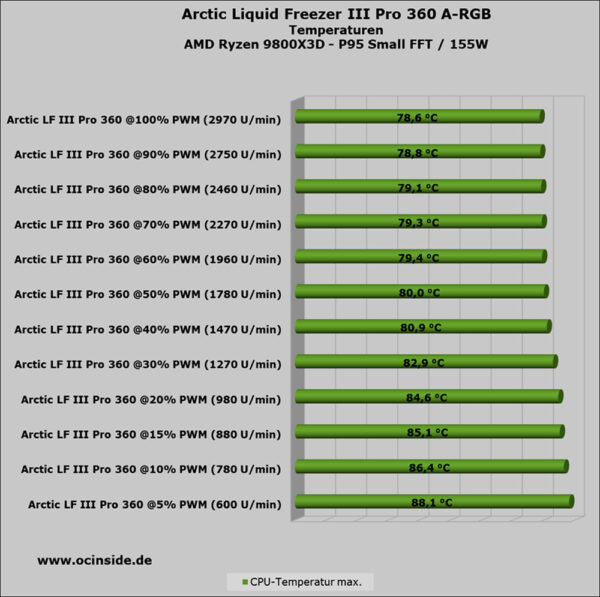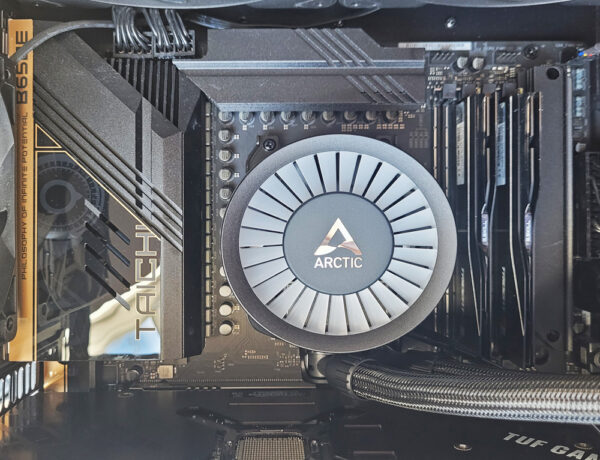
Test setup and results …
To test the Liquid Freezer III Pro 360 A-RGB, we use our AMD AM5 test system, which consists of the following components.
| Motherboard | ASRock B650E Taichi |
| SSD | Crucial T700 1TB M.2 PCIe 5.0 NVMe SSD CT1000T700SSD3 |
| CPU | AMD Ryzen 7 9800X3D |
| RAM | 2x 24GB DDR5-8000 |
| PSU | Seasonic Vertex GX-850 |
| Graphics card | AMD Radeon RX7900XT |
| Operating system | Windows 11 – Version 23H2 |
In the following performance test of the Liquid Freezer III Pro 360, we concentrate on the essentials and go straight into the Prime95 Small FFT test. The pump always runs at 100% and only the three 120mm fans on the radiator are controlled.
Temperatures Prime95 Small FFT …
Prime95 makes every CPU sweat with the Small FFT test, because this test runs in the processor’s cache so that no data has to be reloaded from RAM, which puts maximum load on the CPU with the AVX code.
In this case, our overclocked Ryzen 7 9800X3D processor consumes 155W, which the cooler has to cope with. However, 155W is not a particular challenge for the LF3 Pro 360 water cooler from Arctic. Even if the fans are set to 0%PWM, the cooling capacity is still sufficient for the heat dissipated, as the fans rotate at least at 600 rpm. At an ambient temperature of 22°C, the CPU reaches a maximum value of 88.1°C, which is not a problem for the Ryzen 9800X3D and the background noise remains pleasantly quiet. A throttling of the CPU clock frequency would only occur above 95°C.
Up to approx. 1500 rpm (40% PWM), the fan noise of the LF3 Pro 360 remains tolerable and the CPU temperature drops to a good 80.9°C, which offers sufficient reserves even in summer temperatures. The noise level also increases significantly at higher fan speeds. From 2000 rpm (60% PWM), the noise of the fans is joined by a whirring noise due to turbulence, which means that the LF3 Pro begins to have a disturbing effect. From 2300 rpm (70% PWM) the volume can only be heard with headphones covering the ears and from 80% PWM it becomes really unpleasant, which finally ends at 3000 rpm in a strong noise with clear vibrations. From 60% PWM (1960 rpm) to the maximum speed, the CPU temperature of the 9800X3D only drops by 0.8° from 79.4°C to 78.6°C. So much ado about nothing, at least with the Ryzen 9800X3D.

Conclusion on temperature …
Obviously, the maximum 155W consumed by our AMD Ryzen 7 9800X3D does not pose a particular challenge for the new Liquid Freezer III Pro 360, as no critical temperatures occur on the processor even at the minimum possible fan speed. The LF3 Pro only has a significant advantage over the conventional LF3 above 200W. In comparison with a Liquid Freezer II 360, there is even a virtual tie at 1800 rpm, as the temperature difference of 0.1°C determined by us is within the range of measurement accuracy.
Volume …
It is not surprising that Arctic does not specify a volume for the Liquid Freezer III Pro. Because at a maximum speed of 3000 rpm, the conditions in the PC case are stormy. Unfortunately, vibrations are also added from 2200 rpm, which cause the PC case to vibrate significantly and make the already dramatic background noise even worse. Without headphones, you can hardly concentrate on what’s happening on the screen from 2000 rpm. The LF3 Pro is therefore aimed at users who are looking for the highest possible performance without regard to noise and who power their processors with at least 200W.
Arctic Liquid Freezer III Pro 360 A-RGB Result and general impression …


